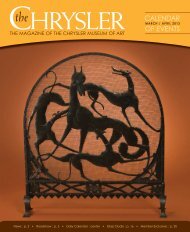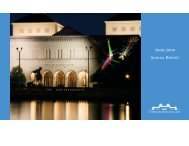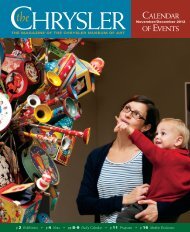View PDF - Chrysler Museum of Art
View PDF - Chrysler Museum of Art
View PDF - Chrysler Museum of Art
Create successful ePaper yourself
Turn your PDF publications into a flip-book with our unique Google optimized e-Paper software.
E X H I B I T I O N S<br />
UPCOMING EXHIBITIONS<br />
Barton Myers: Norfolk Visionary<br />
September 30 at the Moses Myers House<br />
Mayor Barton Myers transformed his city from a prosperous<br />
coastal town into a thriving modern metropolis. Thanks to a<br />
generous gift from T. Parker Host, the Moses Myers House<br />
honors this “first citizen <strong>of</strong> Norfolk” with a display <strong>of</strong> objects<br />
and images highlighting his extraordinary life.<br />
To Live Forever: Egyptian Treasures<br />
from the Brooklyn <strong>Museum</strong><br />
October 14, 2009 –<br />
January 3, 2010<br />
in the Large<br />
Changing Gallery<br />
For more information on this<br />
blockbuster exhibition,<br />
please see this issue’s cover<br />
story on pages 2-3.<br />
Upper Part <strong>of</strong> a False Door <strong>of</strong> Sethew, Old Kingdom, ca. 2500-2350 B.C.E.<br />
Limestone, painted 22 1 /16 x 20 1 /2 x 4 15 /16 in. (56 x 52 x 12.5 cm)<br />
place found: Giza, Egypt, Africa Charles Edwin Wilbour Fund<br />
Photographs<br />
by Eliot Porter<br />
October 24, 2009 –<br />
February 28, 2010<br />
in the Kaufman<br />
Theatre Lobby<br />
Continuing our downstairs<br />
series highlighting great<br />
photography from the<br />
<strong>Museum</strong>’s permanent<br />
collection, this exhibition<br />
focuses on the striking color<br />
landscapes and nature images<br />
<strong>of</strong> Eliot Porter (1901–1990).<br />
<strong>Art</strong>ist, chemist, physician, and<br />
naturalist Porter was among<br />
the first to adopt the newly<br />
developed dye transfer process.<br />
Beginning in 1939 Porter<br />
literally created a new way <strong>of</strong> presenting<br />
nature. His large-format prints combine<br />
precise observation with rich and<br />
resonant color.<br />
Eliot Porter (American, 1901–1990)<br />
Aspens by Lake from Trees portfolio,<br />
1988, Gift <strong>of</strong> Joseph C. French, Jr. and<br />
John Wawrzonek<br />
©Amon Carter <strong>Museum</strong> Archive<br />
Action Paintings at the <strong>Chrysler</strong><br />
October 17, 2009 – April 11, 2010<br />
in the Waitzer Community Gallery<br />
In the pivotal years around World War II, a group <strong>of</strong> American<br />
avant-garde artists centered in New York began to create a new<br />
form <strong>of</strong> painting that challenged both aesthetic tradition and<br />
public expectation. Their canvases no longer depicted<br />
recognizable subjects, but instead focused on the act <strong>of</strong> painting<br />
itself. Influenced by Freudian psychology and emerging notions<br />
<strong>of</strong> the subconscious, firebrands like Jackson Pollock and Franz<br />
Kline channeled their spontaneity and creative dictates into a<br />
vital form <strong>of</strong> abstraction. The canvas became “an arena in which<br />
to act,” their work, “action painting.” With pigment dripped,<br />
flung, stroked, and slashed across their canvases, these young<br />
rebels forged a radically new vocabulary <strong>of</strong> artistic gesture that<br />
helped birth Abstract Expressionism and dominated progressive<br />
American painting well into the 1960s.<br />
As an enthusiastic collector <strong>of</strong> Action Painting, Walter P. <strong>Chrysler</strong>, Jr. befriended many <strong>of</strong> the movement’s founders and<br />
purchased major examples <strong>of</strong> their work. Though many <strong>of</strong> these acquisitions (including canvases by Hans H<strong>of</strong>fmann,<br />
Pollock, and Kline) are today on display in our McKinnon Galleries <strong>of</strong> Modern <strong>Art</strong>, many more have remained in our<br />
storage vaults—until this exhibition that encourages viewers to revel in the pure optical pleasure <strong>of</strong> paint applied to<br />
canvas and to survey a wide range <strong>of</strong> responses, from intensely emotional to the lyrical and serene.<br />
Michael Goldberg<br />
(American,<br />
1955-1956)<br />
Red Sunday<br />
Morning, 1955–56<br />
Gift <strong>of</strong> Walter P.<br />
<strong>Chrysler</strong>, Jr.<br />
7

















